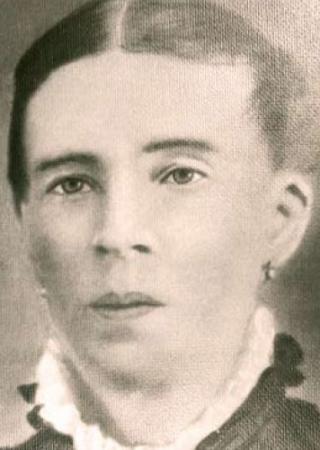- Departments
- Residents
- Business
- Visitors
Eliza Barrett: Forgotten Founder of Chehalis
Return to Take the Historic Downtown Chehalis Walking Tour
Taken from Historic Downtown Chehalis - A Public Guide, October 1992
Eliza Tynan Saunders Barrett (1824-1900) is unrecognized today for the pivotal role she played in shaping the urban form of modern Chehalis. The present site of Chehalis is largely located on land once owned by Eliza Barrett and her husband Schuyler Saunders. Following her divorce from Saunders in 1859, Eliza controlled over three hundred acres of land in Chehalis, and for almost forty years her decisions about land speculation and development guided urban growth.
Eliza Tynan was an Irish immigrant to the United States who was working as a waitress at Fort Vancouver, when she met and married Schuyler Saunders in 1851. Shortly thereafter, the couple moved to the Chehalis Valley and filed a claim under the Donation Land Claim Act, an early version of the Homestead Act unique to the Pacific Northwest. After nine years of marriage, in which Schuyler and Eliza had five children, she married three more times. Her second husband, Mr. McGuire, deserted both her and their daughter; a third marriage (in 1865) to H.F. Basye, produced two children and ended in divorce. A fourth marriage to John C. Barrett also ended in divorce when John attempted to have Eliza sign documents that she was unsure of. Eliza chose to keep this husband’s last name until her death in 1900.
Because of her considerable real estate holdings, a number of men, including several husbands, attempted to take advantage of her. It is said that she could neither read nor write, but she must have been a quick learner. Whether out of trepidation after being cheated once too often, or out of well-placed shrewdness about the pattern of urban growth, Eliza Barrett chose to sell and develop her property cautiously. Chehalis promoter William West was one of her many critics. “The growth of Chehalis,” he asserted in his memoirs, “was greatly hindered by the reluctance of the owner of the land to lay off a townsite, or to sell any land to anyone else that would do so, only a few blocks being laid off at any one time, so that the population increased very slowly.”
Eliza Barrett was in no rush to join the men anxious to make a fast buck in real estate promotion, even as the village evolved around her. She subdivided (or platted) a small parcel in 1875 and five more between 1881 and 1883 -- actions that failed to satisfy local boosters -- but Barrett held her ground. Eventually, between 1888 and 1893, Eliza Barrett sold or platted a total of ten sizable parcels and even decided to develop a couple of lots herself. Significantly, her decisions about land use and civic progress emphasized priorities rather different from the materialistic calculations of city fathers. She chose to construct the first music hall in Chehalis, the Tynan Opera House (1889). She is also credited with building the first Catholic church (1889) and a Catholic boarding school for girls (1895), municipal contributions that reflected her cultural roots as an Irish-American living in a predominantly Protestant community. Her one purely commercial venture was the construction of the Barrett Block (1891), across Chehalis Avenue from the present county courthouse.
None of these structures survives today. Their absence is mute testimony to how Eliza Barrett’s contribution to urban growth has faded from public memory. While streets in the Alfred Street Addition (1890) carried the first names of Eliza’s children, including her four sons by Schuyler Saunders (James, Alfred, William, and Joseph), the only architectural monument to Eliza Barrett’s life is her gravestone in Fern Hill Cemetery. In a final indignity, the marker misspells her last name.

